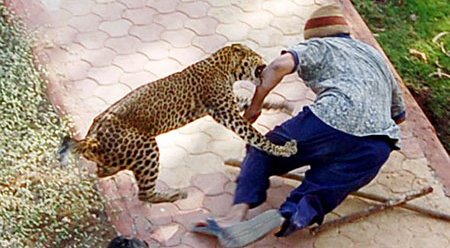
It’s spring time, and that means it’s time to remind everyone that feeding wildlife, whether directly or indirectly, is never a good idea. Wildlife encounters often increase with the availability of food, and feeding can result in an attack, injury, damaged property and often the death of the animal.
“When there are conflicts between humans and wild animals, the animals lose,” said Eric Loft, Chief, DFG Wildlife Branch. “Don’t feed wild animals. They don’t need our handouts, they need our respect. We should all take responsibility for the wild animals whose habitat we share. When humans are careless, wild animals usually pay the price.”
Native wild animals have natural instincts about what, when and where they should eat. Those that become accustomed to being fed may become dependent on human generosity and expand their activities to get more food from people. These animals can damage fences and structures, become pests and threaten human safety in the process.
People who feed wildlife mean well, but doing so upsets an animal’s natural diet, puts the animal at unnecessary risk and often disrupts the natural survival instincts of the animal.
“It’s never a good idea to feed wildlife; it’s as simple as that,” said DFG Senior Biologist Terry Palmisano. “When people feed wildlife, animals become habituated to that source of food, which can lead to unnaturally bold or aggressive behavior. That type of behavior results in conflicts between wildlife and humans and most often leads to the death of the animal.”
Preventing human and wildlife conflicts is the goal of DFG’s “Keep Me Wild” campaign, which encourages people to respect all wildlife by leaving them alone and allowing them to live as wild animals.
The most common problems begin with people who leave pet food outside at night, intentionally put food out for wildlife or allow animals access to crops.
DFG urges pet owners to feed pets early in the day and to retrieve dishes at night, or feed pets indoors. If a pet door is used, owners should be aware that some animals – particularly raccoons and skunks – may use that door to enter the house in search of an easy meal. Lockable pet doors with manual locks are available as are doors that will open only when pets wearing magnetic collars attempt to enter.
Palmisano also warns that people who feed wildlife are at greater risk of being attacked when animals grow accustomed to being fed and then have that feeding disturbed in some way. People who feed animals are also at a greater risk from the spread of disease and parasites.
Urban areas often have an array of turkeys, skunks, opossums and raccoons looking for food, with predators such as coyotes, bobcats and mountain lions following that prey down into residential neighborhoods. These animals can cause problems for pets and unsuspecting neighbors who may not want the visitors in their yard. For these reasons, it is illegal to feed big game, such as deer and bears.
Appropriate, strong fencing is the best way to protect both your property, wildlife and public resources. While DFG can issue depredation permits to remove certain animals that have already caused damage, wildlife biologists always recommend taking measures to prevent problems before they start.